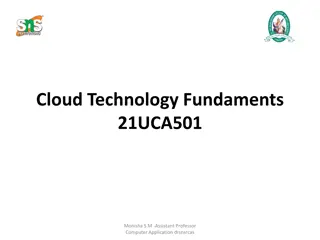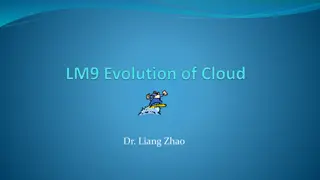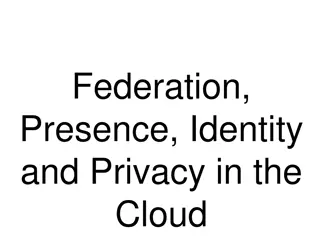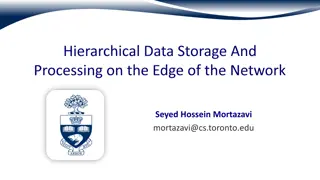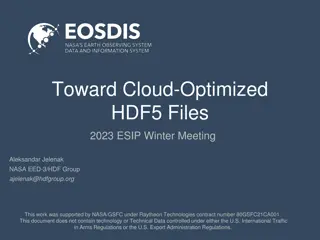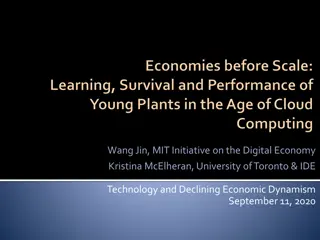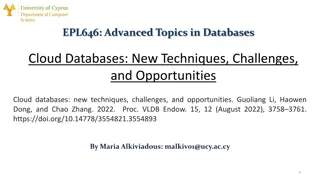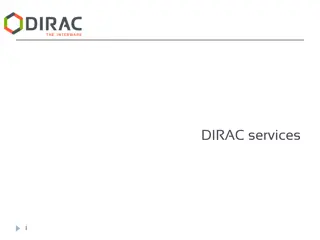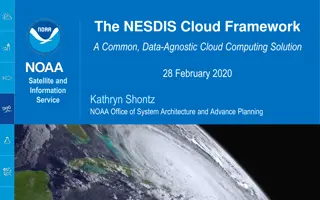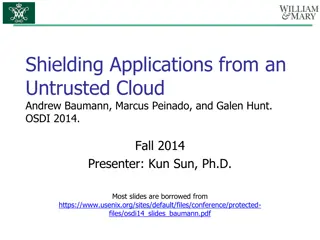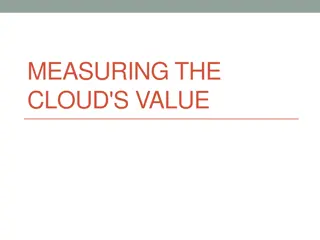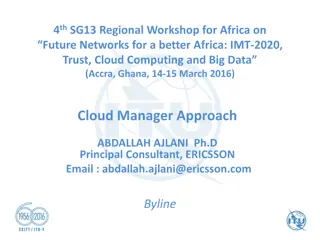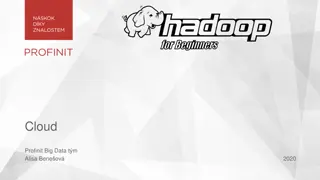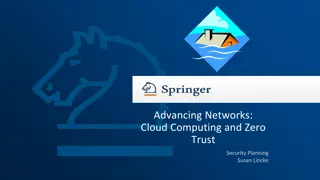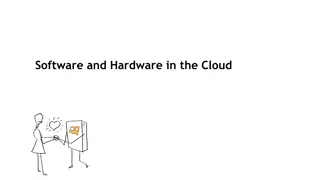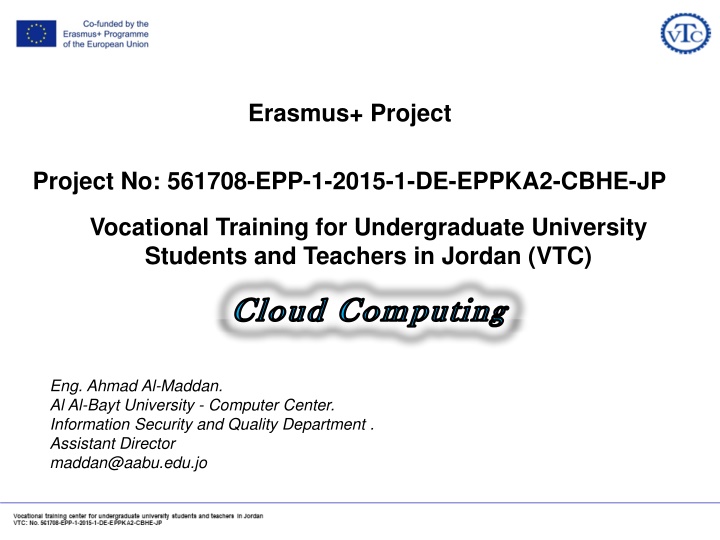
Unveiling the World of Cloud Computing
Explore the revolutionary concept of cloud computing, which offers convenient, on-demand access to a shared pool of computing resources. Discover how cloud services are changing the technological landscape by providing efficient and cost-effective solutions for businesses and individuals alike.
Download Presentation

Please find below an Image/Link to download the presentation.
The content on the website is provided AS IS for your information and personal use only. It may not be sold, licensed, or shared on other websites without obtaining consent from the author. If you encounter any issues during the download, it is possible that the publisher has removed the file from their server.
You are allowed to download the files provided on this website for personal or commercial use, subject to the condition that they are used lawfully. All files are the property of their respective owners.
The content on the website is provided AS IS for your information and personal use only. It may not be sold, licensed, or shared on other websites without obtaining consent from the author.
E N D
Presentation Transcript
Erasmus+ Project Project No: 561708-EPP-1-2015-1-DE-EPPKA2-CBHE-JP Vocational Training for Undergraduate University Students and Teachers in Jordan (VTC) Cloud Computing Cloud Computing Eng. Ahmad Al-Maddan. Al Al-Bayt University - Computer Center. Information Security and Quality Department . Assistant Director maddan@aabu.edu.jo
What you think about What you think about Cloud computing ? ? First to mind when asked what thecloud is, a majority respond it s either an actual cloud, the sky, or something related to weather. Citrix Cloud Survey Guide (August 2012). So don t be afraid if you didn t got it from the first time.
Introduction Introduction Started in the early of 2008 The computing resources become available, power full and less-cost as previously not. This technological orientation leads to new model called cloud computing. The rent and lent procedure between job owners and service providers. The infrastructure providers and the service providers.
Cloud Computing Definition Cloud Computing Definition NIST NIST definition definition of of cloud cloud computing computing: : Cloud computing is a model for enabling ubiquitous(founded every where), convenient, on-demand network access to a shared pool of configurable computing resources (e.g., networks, servers, storage, applications, and services) that can be rapidly provisioned and released with minimal management effort or service provider interaction.
More Simple More Simple It is a service like your phone, electricity, water bell. Don t worry about the location of the sever, just turn-on your device and get your service. The OUTSOURCING OUTSOURCING concept.
Cloud Computing Service Providers Cloud Computing Service Providers Amazon Rackspace VMware IBM Microsoft Critix Google Openstack
Cloud Computing Services Cloud Computing Services cloud storage cloud storage cloud database cloud database cloud application cloud application
Cloud Computing Features Cloud Computing Features No up No up- -front fees: front fees: Pay for just what you rent. Pay as you go. No construction for the infrastructure. Low Low operating operating cost: cost: Dynamic resources rent. resources could be released dynamically to save money from wasted in a non-useable capacities.
Cloud Computing Features (cont.) Cloud Computing Features (cont.) High High scalable: scalable: Rapid development in businesses. Enable the service providers to develop and extend its service to manage and handle this rapid growth in service demands. Easy access: Easy access: Applications well moves with the user. Ease of access. Any net-connected device.
Cloud Cloud Computing Computing F Features eatures (cont.) (cont.) Reducing business risk and maintenance expenses Reducing business risk and maintenance expenses: : Infrastructure providers take the risk. Staff training cost. Maintenance cost.
Cloud Computing Business Models Cloud Computing Business Models Delivers hardware resources such as CPU Physically , or virtual machines controlled by HyperVisor brought users by cloud carrier . Disk space or network components as a service. Client has full control of the virtualized platform. Users are responsible of managing & maintaining their SW s and OS s Platform as a service (PaaS): Platform as a service (PaaS): Its provided by cloud provider. Provide platform resources (application platform as a service) like operating systems and applications. User can deploy and customize their applications (programming languages and tools supported by the cloud provider). Users doesn t have full control but they restricted by the provider constraints. Infrastructure Infrastructure as a service (IaaS as a service (IaaS): ):
Cloud Computing Business Models (cont.) Cloud Computing Business Models (cont.) Software as a service (SaaS): Software as a service (SaaS): Software (application) provide by the cloud provider (on- demand application), The user just use it without any control. This service can update, enhance, maintain and patching this software (applications). Free applications. Network as a service (NaaS): Network as a service (NaaS): Cloud services enabled the users to use network and transport connectivity services. Optimization of resource allocations by considering network and computing resources as a unified whole (VPN, bandwidth on demand (BoD), and mobile network virtualization).
Cloud Computing Types Cloud Computing Types
Cloud Computing Types Cloud Computing Types Public cloud (external cloud): 32% Public cloud (external cloud): 32% Service providers offers their resources as a service to the public. Shifting the risks to infrastructure providers. Scalable and dynamic. Lakes to the security. Private cloud (internal clouds): Private cloud (internal clouds): 10% Designed specifically for single origination(private network). Organization has the highest degree of control over performance. Reliability and security. Organization well need to be charged for that service.
Cloud Computing Types (cont.) Cloud Computing Types (cont.) Hybrid cloud: 58% Hybrid cloud: 58% Combination of public and private cloud models. Address the limitations of each approach. Swings between both(Flexibility). Offers the security and control over application data and expansion in capacity if needed. Cloud Bursting: (application runs in a private cloud or data center and "bursts" to a public cloud in case of increasing demand of computing capacity)
Public Clouds Public Clouds vs. vs. Private Clouds Private Clouds comparison Public cloud Private cloud Initial cost Running cost Typically zero Predictable Typically high Unpredictable Customization Impossible Possible Privacy No (Host has access to the data) Impossible Yes Single sign-on Possible
Cloud Computing Cloud Computing Cons Security Security breaches Outages Outages Slow Slow speeds speeds. . Limited Limited features Pros Pros Convenience Convenience (anywhere) (anywhere) Backups Backups Collaboration (sharing) Collaboration (sharing) Environmentally Environmentally friendly friendly breaches features
The Future of Cloud Computing The Future of Cloud Computing Cloud computing is the future Clouded systems Expected operating systems is going to run on the cloud People Fears of the roll of IT managers. Cloud is a competitive player in the business.
Can cloud be green ?? Can cloud be green ?? Yes, due to Cloud computing business models (SaaS, NaaS, IaaS, PaaS) Business Efficiency Energy Efficiency = Efficiency itself is Green. virtualization (resource saving cost saving energy saving)

